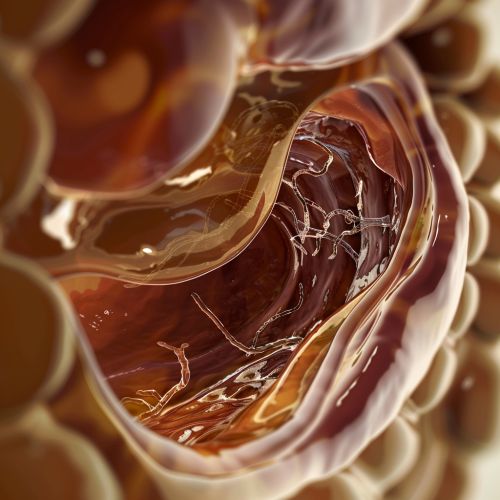Gastrointestinal organs: Difference between revisions
(Created page with "== Overview == The gastrointestinal (GI) tract, also known as the digestive tract, is a complex system of organs responsible for the ingestion, digestion, absorption, and excretion of food and nutrients. This intricate system is essential for maintaining the body's overall health and homeostasis. The GI tract includes the mouth, esophagus, stomach, small intestine, large intestine, rectum, and anus. Additionally, accessory organs such as the liver, pancreas, and gallbla...") |
No edit summary |
||
| Line 15: | Line 15: | ||
The stomach is a hollow, muscular organ that stores and further digests food. It secretes gastric juices, including hydrochloric acid and pepsin, which break down proteins. The stomach's muscular walls churn food into a semi-liquid mixture called chyme. The pyloric sphincter regulates the passage of chyme into the small intestine. | The stomach is a hollow, muscular organ that stores and further digests food. It secretes gastric juices, including hydrochloric acid and pepsin, which break down proteins. The stomach's muscular walls churn food into a semi-liquid mixture called chyme. The pyloric sphincter regulates the passage of chyme into the small intestine. | ||
[[Image:Detail-91361.jpg|thumb|center|Close-up image of a human stomach showing its muscular structure and internal lining.|class=only_on_mobile]] | |||
[[Image:Detail-91362.jpg|thumb|center|Close-up image of a human stomach showing its muscular structure and internal lining.|class=only_on_desktop]] | |||
== Small Intestine == | == Small Intestine == | ||
Latest revision as of 15:21, 21 June 2024
Overview
The gastrointestinal (GI) tract, also known as the digestive tract, is a complex system of organs responsible for the ingestion, digestion, absorption, and excretion of food and nutrients. This intricate system is essential for maintaining the body's overall health and homeostasis. The GI tract includes the mouth, esophagus, stomach, small intestine, large intestine, rectum, and anus. Additionally, accessory organs such as the liver, pancreas, and gallbladder play crucial roles in digestion.
Mouth
The mouth, or oral cavity, is the entry point for food and liquids. It contains the teeth, tongue, and salivary glands. The teeth mechanically break down food into smaller pieces, a process known as mastication. The tongue assists in manipulating food and contains taste buds that detect flavors. Salivary glands produce saliva, which contains enzymes like amylase that begin the chemical breakdown of carbohydrates.
Esophagus
The esophagus is a muscular tube that connects the mouth to the stomach. It transports food and liquids through peristalsis, a series of wave-like muscle contractions. The lower esophageal sphincter (LES) at the junction of the esophagus and stomach prevents the backflow of stomach contents, protecting the esophagus from acidic gastric juices.
Stomach
The stomach is a hollow, muscular organ that stores and further digests food. It secretes gastric juices, including hydrochloric acid and pepsin, which break down proteins. The stomach's muscular walls churn food into a semi-liquid mixture called chyme. The pyloric sphincter regulates the passage of chyme into the small intestine.


Small Intestine
The small intestine is a long, coiled tube where most digestion and nutrient absorption occur. It consists of three sections: the duodenum, jejunum, and ileum. The duodenum receives chyme from the stomach and digestive enzymes from the pancreas and bile from the liver. The jejunum and ileum are primarily involved in nutrient absorption through villi and microvilli, which increase the surface area for absorption.
Duodenum
The duodenum is the first part of the small intestine and plays a critical role in the chemical digestion of chyme. It receives bile from the gallbladder and digestive enzymes from the pancreas. Bile emulsifies fats, while pancreatic enzymes break down carbohydrates, proteins, and lipids.
Jejunum
The jejunum is the middle section of the small intestine. It is highly vascularized and has numerous folds, villi, and microvilli that maximize nutrient absorption. Most carbohydrates, proteins, and vitamins are absorbed in the jejunum.
Ileum
The ileum is the final section of the small intestine. It absorbs bile acids, vitamin B12, and any remaining nutrients not absorbed by the jejunum. The ileocecal valve regulates the flow of chyme from the ileum into the large intestine.
Large Intestine
The large intestine, or colon, absorbs water and electrolytes from indigestible food residues, forming solid feces. It consists of the cecum, ascending colon, transverse colon, descending colon, sigmoid colon, rectum, and anus. The large intestine also houses beneficial bacteria that aid in fermentation and vitamin production.
Cecum
The cecum is a pouch-like structure at the beginning of the large intestine. It receives chyme from the ileum and begins the process of water and electrolyte absorption. The appendix, a small tube attached to the cecum, is thought to play a role in immune function.
Colon
The colon is divided into four sections: ascending, transverse, descending, and sigmoid. It absorbs water and electrolytes, compacts feces, and stores them until defecation. The colon's bacterial flora ferment undigested carbohydrates, producing gases and short-chain fatty acids.
Rectum and Anus
The rectum stores feces until they are expelled through the anus during defecation. The anus has two sphincters: the internal anal sphincter (involuntary control) and the external anal sphincter (voluntary control), which regulate the passage of feces.
Accessory Organs
Accessory organs, including the liver, pancreas, and gallbladder, play vital roles in digestion by producing and storing digestive enzymes and bile.
Liver
The liver is the largest internal organ and performs numerous functions, including bile production, detoxification, and metabolism of carbohydrates, proteins, and fats. Bile produced by the liver is stored in the gallbladder and released into the duodenum to aid in fat digestion.
Pancreas
The pancreas has both exocrine and endocrine functions. Its exocrine function involves the production of digestive enzymes (amylase, lipase, proteases) and bicarbonate, which are released into the duodenum. Its endocrine function involves the secretion of insulin and glucagon, which regulate blood glucose levels.
Gallbladder
The gallbladder is a small, pear-shaped organ that stores and concentrates bile produced by the liver. During digestion, it releases bile into the duodenum through the common bile duct to aid in the emulsification and absorption of fats.
